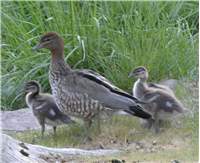Family
Anatidae
Genus
Chenonetta
Species
jubata
Threats/Control Methods - Regional
Australian Wood Ducks can cause production losses to certain agricultural activities and in some states under certain situations it is legal to control the species on private land via shooting. Due to the land-loving nature of this species, introduced predators such as Foxes (Vulpes vulpes), Dogs (Canis familiaris) and Cats (Felis catus) will attack both young and adult birds.
Threats/Control Methods - Local
Water bodies in urban areas are less resilient to periods of droughts or extreme weather events and floods, causing a build-up of toxins and dangerous algae levels, which may impact the health of this species in extreme cases.
Local/Urban Actions
The species is secure in the ACT and requires no action to maintain its population. Hand feeding should be avoided, as the population currently has ample natural food supplies and occurs in significant numbers.
Common Names
Australian Wood Duck, Maned Duck, Black Duck, Maned Goose.
Distinguishing Features
Adults range from 46cm-50cm in length and a wingspan of 76cm-85cm. Females are slightly smaller than males. In males the head is wholly black/brown, with breast feathers being dark brown to black and wings grey. In females, feathers around the eyes form a white stripe, a short black/brown mane is present on the top of the head and the body is a light mottle grey while the back and rump are a dark brown. Young are covered in a soft down with underparts grey and the back and rump darker.
Survey Techniques
Call and visual identification. This species can easily by identified visually through its distinct shape and posture.
Species Call
A nasal 'mew' or an unmistakable nasal 'honk' when in flight.
Similar Species
The only locally detected waterbird with any similarity is the Pacific Black Duck (Anas superciliosa ).
Distribution
Found across most of Australia excluding the arid centre and most of the Northern Territory. Also found in New Zealand. Within the ACT, the species is often found in urban wetlands, farm dams and along the Murrumbidgee and Molonglo Rivers (COG).
Country of Origin
Australia.
Conservation (Pet/Pest) Status - Regional
According to COG, breeding has increased markedly since the 1980s.
Conservation (Pet/Pest) Status - National
Secure, not listed as a threatened species under the EPBC Act 1999. Considered a pest to some forms of agriculture.
LSCCES Population
This is a common duck and is often seen on the grounds of the ANU and the National Museum, congregating in large groups.
Associated vegetation community
This species prefers lightly timbered areas near water and well-watered lawns or ovals with short grass.
Limiting Resources
Green grass is necessary for the species, meaning droughts can limit their preferred habitat and cause the species to congregate in urban watered grasslands.
Breeding
The Wood Duck breeds within eucalypt tree hollows. Within the ACT, they will begin inspecting hollows in July. Young are found from September through to January. Their eggs are a pale creamy-white colour.
Behaviour
Males and Females form life-long pairs that can be aggressively protective of their young. Although capable of swimming, Australian Wood Ducks prefer land and often congregate on lawned areas in large groups while grazing on grass.
Functional Group
Food Species
Any common grasses, particularly, summer grass (Paspalidum), wallaby grass (Danthonia), couch (Cynodon), rice (Oryza), smartweed (Polygonum), as well as other ground cover such as clover and herbs.
Predators
Black Rats (Rattus Rattus), Silver Gulls ( Larus novaehollandiae) and Swamp Harriers (Circus approximans) may predate on the species when in water or when exposed on land. The Purple Moorhen (Porphyrio porphyrio ) will steal eggs and may kill ducklings.
Interesting Fact
In spring it is not uncommon to see unwary ANU students fleeing from aggressively protective parents. This often leads to students avoiding the species for most of the year.
The species is listed as legal for recreational hunting in several states and as a result is a popular game bird.
References - (reader suitability of references, P=Primary teachers, S=Secondary students, T=Tertiary students and researchers)
Books:Canberra Ornithologists Group. 2000. Birds of Canberra gardens. Canberra Ornithologists Group and Urban Services, ACT Government, Canberra. S, T
Canberra Ornithologists Group & McComas Taylor. 1992. Birds of the Australian Capital Territory. An Atlas. Canberra Ornithologists Group & National Capital Planning Authority. Canberra, Australia. S, T
Dengate, J. 2000. Attracting Birds to your Garden. New Holland. Sydney. S, T
Lintermans,M. & Osborne, W. 2002. Wet & Wild: A Field Guide to the Freshwater Animals of the Southern Tablelands and High Country of the ACT and NSW. Environment ACT. Canberra, Australia. P, S, TPringle, J.D. 1985. The Waterbirds of Australia. Angus and Robertson/National Photographic Index of Australian Wildlife, Sydney S, T
Internet:Australian Museum. 2005. Australian Wood Duck. [online]. Available at: http://www.birdsinbackyards.net/finder/display.cfm?id=185 P, S, T
Canberra Orinthologists Group: Canberra Ornithological Group (COG). 2004. Birds of Canberra Gardens. COG and the ACT Department of Urban Services. [online]. Available at:http://garden.canberrabirds.org.au/ P, S, T
Online Publications:Department of Conservation and Land Management W.A. 2005. Fauna Note No. 10/2005. [online]. Available at: http://www.naturebase.net/plants_animals/living_with_wildlife/pdf/1005_destruction_of_ducks.pdf S, T
Department of Sustainability and Environment. 2004. Australian Guide to Waterfowl; Wood Duck, Maned Duck. [online] Available at: http://www.dse.vic.gov.au/dse/nrenrt.nsf/LinkView/D67AE43730E6837E4A2567C300216C884E899088F680A8BE4A256DEA00243694 S, T
Nix, H. and Cunningham, R. 2006. Birds of the Lower Sullivans Creek Catchment, Canberra ACT. Prepared for the Life in the Suburbs project using data from the Lower Sullivans Creek Catchment Ecological Survey (LSCCES). Australian National University. Canberra. [online]. Available at: http://www.lifeinthesuburbs.com.au/category.php?id=65 S, T


 Top
Top Top
Top